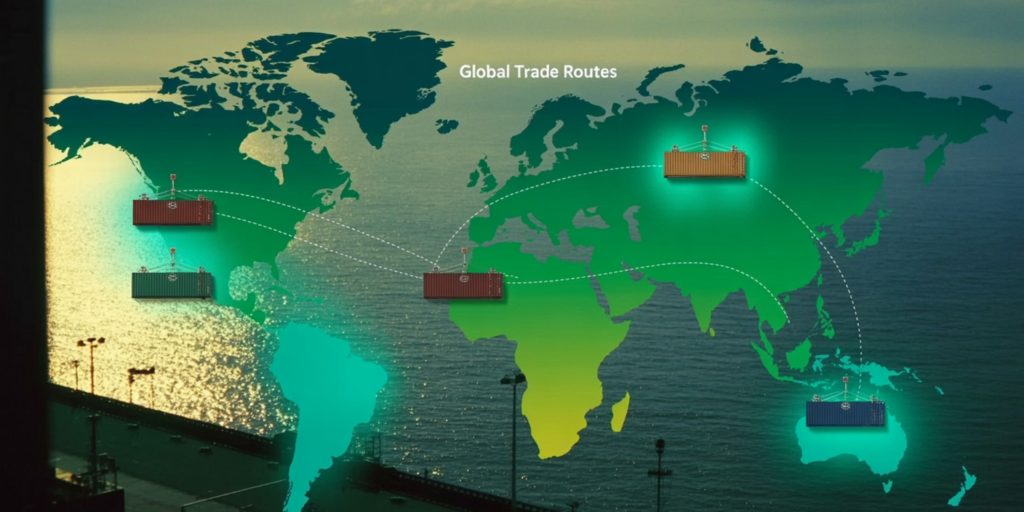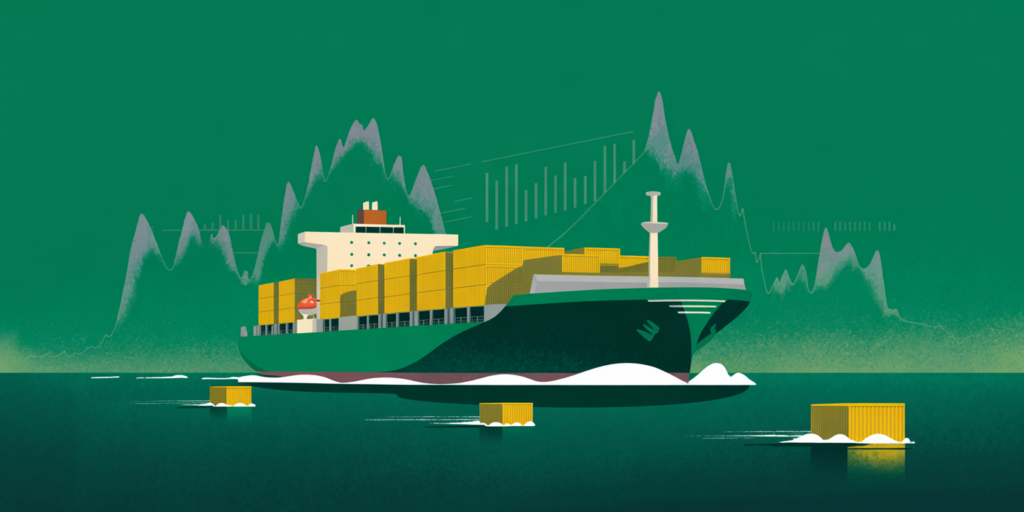Port Congestion & Capacity Management Strategies
If the pandemic taught us anything about supply chains, it’s that congestion isn’t a one-time problem – it’s a recurring risk driven by demand swings, weather, labor disputes, capacity changes, and policy changes.
In 2025, global schedule reliability has improved, but still hasn’t reached pre‑pandemic norms. According to Sea‑Intelligence’s Global Liner Performance (GLP) report, global reliability hit 65-67% in May-June 2025, the best since 2023 – but performance varies widely by carrier and trade.

With congestion affecting everything from freight rates to inventories, it’s a major factor in capacity planning.
This guide breaks down why congestion happens, what it costs, and the practical moves importers can use to keep goods moving. Read on to learn everything from early warning signals and diversified routing to smarter inventory buffers and faster pivots when plans change.
Understanding Port Congestion
What is port congestion?
In a nutshell, port congestion happens when more containers arrive than the port can handle.
To measure effects, ports typically track how long ships wait for a berth, how crowded the yard is, and how long it takes for containers to be picked up
Key causes of port congestion
Port congestion usually comes from a mix of long-term limitations and sudden shocks.
Long-term constraints (hard to change):
• Limited berth space or deep-water access
• Not enough cranes, trucks, chassis, or rail connections
• Older systems that slow coordination
Short-term disruptions (fast + unpredictable):
• Demand spikes
• Labor actions
• Severe weather
• Policy changes that suddenly push volume from one port to another
When these pressures stack up, the effects ripple quickly: Ships wait offshore, containers pile up, truckers can’t get appointments, rail connections are missed, and detention/demurrage fees start adding up – all of which means inventories run late, and customers feel the pain.
Simply put: when a port slows down, your supply chain slows down – and costs rise.
Global congestion hotspots and trends
Port congestion doesn’t happen everywhere at once; rather, “hot spots” continually shift. Here’s what’s changing in 2025, and what it means for importers.
North America: A Moving Target
The U.S. West Coast has become more reliable again in 2025, but labor risk, weather, and shifting trade policy still push importers to spread shipments across West, East, and Gulf ports.
Southeast Asia: Rapid Growth
Vietnam continues to expand as a major export base.
Its Cai Mep–Thi Vai ports handled around 6.5M TEU in 2024 and are adding capacity – meaning more deep-water space and more weekly sailings.
For importers, this opens more routing choices, potentially better reliability, and more competitive rates as carriers fight for volume
South Asia: New Capacity Coming Online
Sri Lanka’s Colombo port opened a new automated terminal in April 2025, adding more capacity and faster handling. This helps reduce bottlenecks for regional and transshipment cargo.

Impacts on Supply Chain & Costs
Port congestion affects importers in three major ways: freight rate volatility, inventory disruption, and extra fees.
Freight rate volatility
When ports clog, vessel schedules get delayed and capacity gets shuffled. Carriers may respond by canceling sailings, rerouting, or adjusting service – moves that can cause freight rates to swing.
In 2025, spot prices climbed early in the year, then slid through the summer as more capacity came online. By late August, Freightos Global Container Freight Index showed rates around $1900.
Lower prices can help budgets, but they also create headaches, especially for importers who booked at higher levels before the market softened. That volatility makes forecasting and budgeting harder for smaller importers that rely on predictable landed costs.
In short: congestion doesn’t always make freight expensive, but it does make pricing less predictable, which adds planning risk.
Inventory and Customer Service
Even a few days of delay at port can throw off inventory plans.
If you over-buffer, you tie up cash and warehouse space. If you cut it too close, missed berths and rail connections can ripple into stock-outs, backorders, emergency replenishment, split shipments, and higher last-mile costs – all of which create major planning challenges.
Extra Fees (Detention & Demurrage)
When containers sit longer, detention and demurrage fees can add up quickly, even when the delay isn’t your fault.
Recent U.S. FMC rules (2024–2025) were designed to make those charges fairer by clarifying who can be billed, requiring clearer invoices, and setting time limits for billing. This means better protection and more transparency for importers – but you still need basic processes in place.
So, what can you do to help manage these risks? Glad you asked.
Capacity Management Strategies
Most of the heavy lifting for mitigating congestion happens on the port and policy side. Let’s look at these strategies first – because understanding them can inform decisions about routes, partners, and inventory plans.
Stronger Infrastructure
Ports investing in upgrades like on-dock rail can reduce truck moves and get containers inland faster, easing pressure at the terminal.
For example, Long Beach’s Pier B project aims to triple rail capacity, which means fewer containers clogging gates and yards.
Automation also helps – automated stacking cranes and smart-yard systems speed up container moves and improve hand-offs, allowing ports to handle more volume without expanding their footprint.
Ports with these capabilities usually move containers out faster, which means fewer bottlenecks and lower storage fees.
Data Sharing
Some ports are rolling out digital tools like predictive ETAs, digital twins, and port community systems. These help terminals, truckers, rail, and customs coordinate more smoothly.
For example, Rotterdam uses digital modeling and shared data platforms (like Portbase) to give all players real-time container information.
Better transparency into changes or delays means faster adaptation.
Policy Signals
Environmental policy is also reshaping how ships call at ports. In California, the At-Berth rule encourages vessels to plug into shore power, which can influence berth time and even port selection. Meanwhile, the EU Emissions Trading System (ETS), which began pricing maritime CO₂ in 2024, adds a carbon cost component to routing and carrier decisions.
These policies are not the main drivers of congestion, but they can shape which ports are more reliable over time.
Practical Steps for Importers
You can’t stop bottlenecks completely – but you can make them cheaper and less disruptive. Here are some steps to take:
Start Early in the Process
Don’t wait for congestion to throw a wrench in your plans – factor the possibility into your planning. This includes sharing short-term demand signals with your freight forwarder, booking early to create buffer times, especially during high-risk periods, and budgeting for extra fees – which are unfortunately often inevitable.
Build Routing Flexibility
Work with your forwarder to split shipments across multiple ports, line up inland rail and transload options, and consider alternate hubs during peak pressure.
Line up these “plan B” options before you need them so you can keep freight moving when your main port stalls.
Prioritize What Matters Most
When vessels are delayed, prioritize high-value products and aim to move full orders together. Partial shipments often trigger extra trucking, handling, and receiving work – so consolidating helps keep costs and chaos down.
Hold the Right Inventory in the Right Place
The best buffer isn’t “more stock” — it’s the right stock. Items that move quickly or can be easily substituted need less backup. Unique or slow-to-replace products often need more.
Work With Partners + Platforms That Keep You Flexible
When congestion hits, flexibility is everything. Using a platform like the Freightos Marketplace lets you compare rates, routes, and modes from dozens of providers in real time, so you can choose the best option for cost and transit time.
However you book, work with freight forwarders that will partner with you in adjusting to any changes that arise.
Use Market and Lane Data To Make Better Decisions
Strong data helps you decide when to book early, when to switch ports, or when to adjust buffers. Tools like Freightos Terminal give importers market pricing, transit-time trends, and lane-level insights, helping you plan around congestion instead of reacting to it.

Capacity Management Checklist
✅ Use real-time ETAs and port data to spot delays early
✅ Build routing flexibility
✅ Keep the right inventory in place
✅ Use flexible platforms + good market data
FAQ
What actually causes port congestion?
A mix of factors, including larger ships, limited berths, labor disruptions, severe weather, demand spikes, poor data sharing, and inland constraints (like chassis or rail slots). When one link slows, backups spread across berths, yards, and gates.
How can I reduce the impact on my lead times?
Share forecasts early, book ahead during high-risk periods, and spread shipments across multiple ports or services. Have backup plans like transload or inland rail, and connect shipment milestones to your logistics systems so delays trigger action.
What’s the difference between demurrage and detention?
Demurrage refers to fees for keeping containers inside the terminal too long. Detention refers to fees for holding containers outside the terminal too long. Good planning, clean paperwork, and faster truck moves keep these in check.
How do I choose an alternate port when my main gateway clogs?
Compare depth and crane capacity, sailing frequency, on-dock rail, distance to your warehouse, chassis availability, customs efficiency, reliability history, and total landed cost. Test with a small volume before shifting a lot of freight.
How can digital tools help when networks are disrupted?
They help you see delays early, prioritize orders, compare routing options, and execute a backup plan faster.
Visibility + faster decisions = fewer surprises.


